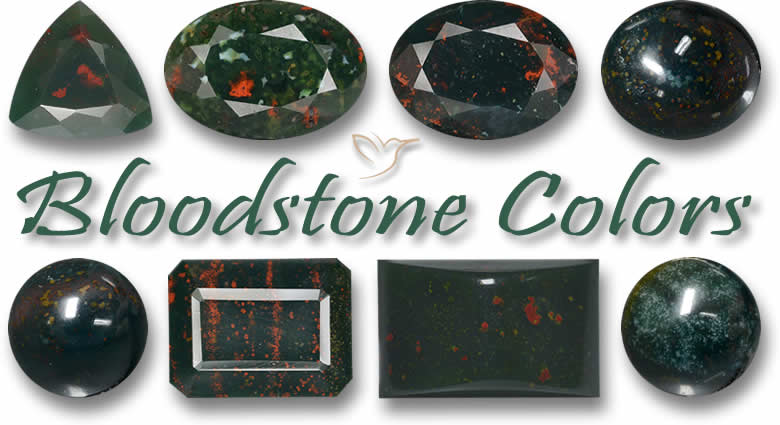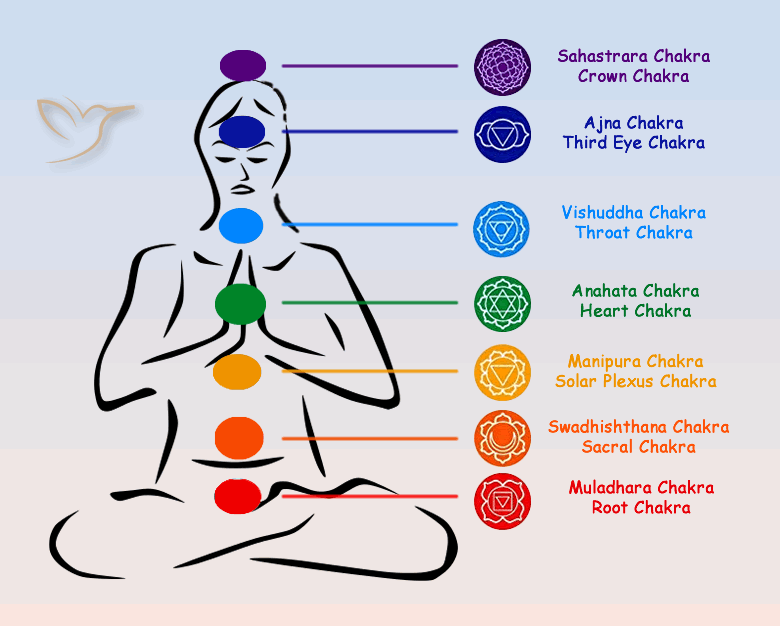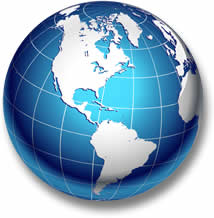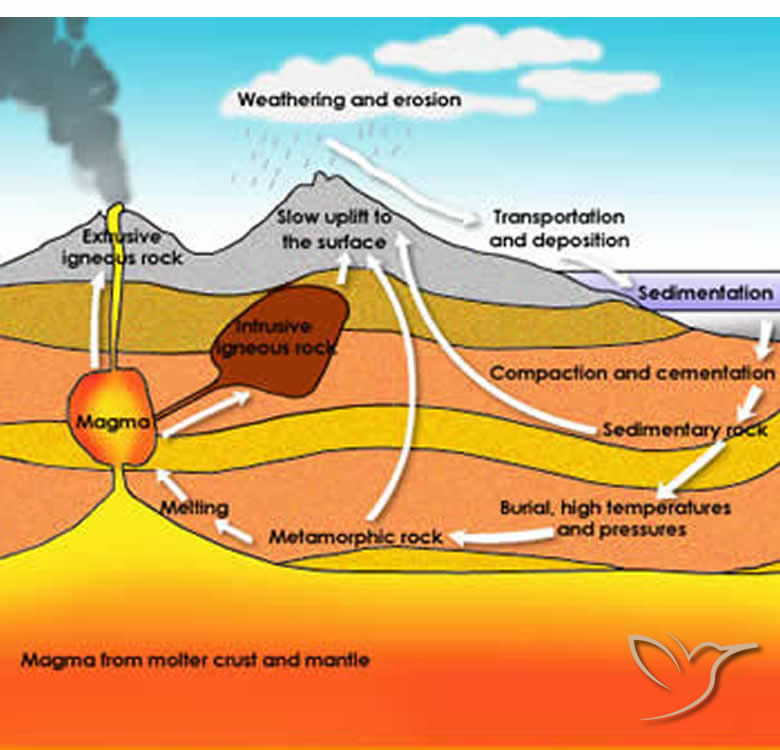Bloodstone Gemstone Information

Introduction
Bloodstone, also known as heliotrope, is a distinctive green chalcedony with red or brown spots resembling blood - that's where the name comes from. This gem has a long history and is often linked to strong healing qualities.
In the gemstone world, few stones carry as much historical and symbolic weight as bloodstone. One of its most well-known stories ties the red spots on the deep green surface to the blood of Jesus, but its meaning goes back even further to ancient civilizations like Babylon, Egypt, and Greece.
From healing abilities and weather control to protection, invisibility, prophecy, love potions, and even justice - bloodstone seems to do it all, doesn't it?
Bloodstone is a deep green chalcedony gem flecked with red, brown, and orange spots. It's related to agate, carnelian, onyx, and jasper. Once used for seals, amulets, signet rings, and small cups, it's now popular in modern pendants, earrings, bracelets, and necklaces.
Bloodstone Colors

Bloodstone is mostly a deep green to nearly black gem with red, orange, or brown spots from iron oxide inclusions, like hematite.
The dark green comes from chlorite or hornblende minerals. These can vary, so the green shade might differ or be uneven across the stone.
The top-quality bloodstone has a solid deep green base with bright red spots or veins spread across it.
Bloodstone Species
Bloodstone has a bit of a mixed-up background, with different names adding to the confusion.
Let's dive into a quick geology overview - promise it'll be brief and more engaging than those school lessons!
Quartz is a mineral of silicon and oxygen. It comes in large-crystal forms like amethyst, citrine, or rose quartz, and tiny-crystal forms like chalcedony.
Bloodstone is a chalcedony type, alongside agate, jasper, onyx, and similar stones, sorted by colors, stripes, or patterns.
Large-crystal quartz like amethyst is transparent to translucent, while tiny-crystal ones like bloodstone are translucent to opaque.
So, bloodstone is chalcedony, which is quartz, which is a mineral.
Other names include heliotrope and blood jasper.
And that's it - no assignments today!
Bloodstone Clarity and Cut

Gemstones fit into three clarity types, with some variations.
Opaque ones block all light, even against a bright source.
Translucent ones let some light through, but you can't see clearly.
Transparent ones allow full light passage, so you can see or read through them.
Bloodstone is opaque and typically polished into cabochons - domed shapes in round, oval, pear, or custom forms for unique jewelry.
Spiritual Meaning of Bloodstone
Disclaimer: The information about the spiritual properties of bloodstone is for informational purposes only and is not a substitute for professional advice. Consult experts for spiritual or personal guidance.
Few gemstones match bloodstone's reputation for spiritual significance and ancient history.
In ancient Mesopotamia, it aided fortune-telling. Babylonian warriors carried amulets to stop bleeding in battle, and Greek and Roman athletes wore it for endurance.
The Leyden Papyrus, ancient Greek texts from Thebes, calls bloodstone the world's greatest thing, useful for spells and recipes.
Known as the 'martyr's stone,' medieval Christians carved crucifixes and martyrs into it. Legend says it formed from Jesus' blood on jasper at the cross. Today, it reminds us of sacrifice, encouraging selflessness and aid to others.
Like a modern warrior's charm, bloodstone offers protection from bullying or aggression at work, school, or home. It builds strength to face issues or wisdom to step back.
It can boost motivation, creativity, positivity, and energy when you're feeling low.
Bloodstone and the Chakras
Disclaimer: The information about the spiritual properties of bloodstone is for informational purposes only and is not a substitute for professional advice. Consult experts for spiritual or personal guidance.
Chakras are energy centers in the body, also called Qi or Prana. Seven exist, each tied to physical, emotional, or mental states and colors: crown (purple), third eye (indigo), throat (blue), heart (green), solar plexus (yellow), sacral (orange), root (red).

Chakras can become unbalanced and need realignment. Chakra stones, colored to match, help with this.
Bloodstone links to the root chakra at the spine's base for its grounding effects. Symbolizing strength, courage, and vitality, it's thought to balance and activate this center.
It may enhance security, stability, and resilience, connecting you to the earth and present moment for safety and trust. The green with red specks resonates with root chakra energies, supporting physical health, emotional balance, and spiritual foundations.
Health Benefits of Bloodstone
Disclaimer: The information about the healing properties of bloodstone is for informational purposes only and is not intended as a substitute for professional medical advice. Please consult a healthcare professional for any health concerns.
Historically, bloodstone helped stop bleeding in battles. Today, it's linked to blood-related issues: regulating pressure, improving flow and circulation, boosting immunity, and detoxifying.
It supports bone marrow, spleen, liver, and kidney health, beneficial during pregnancy, childbirth, PMS, and menopause.
We're not experts, but from experience, wearing it as jewelry is simple for influence. Carry it as a touchstone, hold during meditation, or align with chakras while lying down.
For specific uses, cleanse bloodstone every few days: rinse in tepid water and sun-dry for an hour. Natural water like spring or rain is best, but tap works. For general use, cleanse biweekly.
For deep cleansing, bury in natural soil for a day, then rinse. Remember the spot!
Bloodstone Price

Bloodstone Price List |
||
| Color | Weight range | Price range / USD |
|---|---|---|
| Green with Red | 1ct + | $1.5 - 6/ct |
Most valued bloodstone is deep forest green with random red spots like blood spatter. Opaque, it's cut into smooth cabochons in round, oval, or pear shapes. This enhances its silky polish and sheen.
Available in various sizes for carvings or rings. Large, unique pieces suit modern jewelry at affordable prices.
Bloodstone Discovery and History

With lapis lazuli, turquoise, carnelian, and others, bloodstone was among the first gems humans used. In museums' ancient sections, you'll see Babylonian seals from 3000 BC, Roman rings from Jesus' era, and Christian-engraved crosses.
The Miseroni family's 15th-16th century cups, bowls, and vases with bloodstone are in the Louvre, Prado, and British Museum.
Before 'bloodstone,' it was heliotrope (still in Europe). Earliest sources: Kathiawar Peninsula, Gujarat, India.
Where is Bloodstone Found?

Bloodstone occurs worldwide, with top sources in India, Australia, Brazil, and Madagascar for quality and volume.
It's one of few gems in Scotland - on Rum Island (though whiskey might fit better!).
How is Bloodstone Formed?

Like many gems, bloodstone forms as magma rises and cools.
As it hardens, gas bubbles, cracks, and cavities form.
Silica-rich fluids fill these, crystallizing quartz.
Green from chlorite and amphibole in volcanic rocks; red from iron oxides.
Harder than surrounding rock, it erodes out, washed to rivers as pebbles over millions of years.
Can Bloodstone Be Treated?
Beyond cutting, polishing, or carving, bloodstone isn't typically heated or dyed.
We disclose any treatments on gems we sell.
What Jewelry is Bloodstone Suitable For?
At 6.5–7 on Mohs scale and low cost, bloodstone works for any jewelry. Historically popular in rings, pendants, amulets - now, creativity rules.
Modern designers favor it for men's items; deep greens suit large rings and cufflinks.
Large, irregular shapes perfect for unique pieces; affordable for beginners.
Interesting Facts About Bloodstone
- Natural Viagra? In India, fine bloodstone powder serves as an aphrodisiac.
- Yellow spots instead of red? That's plasma.
- It's well-documented: In Pliny the Elder, Damigeron's 'The Virtues of Stones,' Albert the Great's 'Treatise on Minerals,' and the Leyden Papyrus.
- Leyden Papyrus on bloodstone: The world has no greater thing; it grants wishes, calms rulers, ensures belief, opens doors, breaks bonds and walls.
- Once thought to cause solar eclipses.
- Traditional and alternative March birthstone.
How to Care for Bloodstone
Store in fabric-lined boxes or soft cloth. At 6.5–7 Mohs, separate from harder or softer gems.
Clean with warm soapy water, soft brush; rinse, dry with soft cloth. Avoid ultrasonics or steamers.
Remove jewelry before sports, chores, or gardening.
How Can You Tell a Real Bloodstone?

Buy from reputable sources, but when hunting online, know what to look for.
Check photos or stores: deep green with red flecks, maybe other colors.
Red amounts vary; affects price, not authenticity. Fakes might overdo red.
Not pricey, so few fakes, but real ones shine and are opaque - no light through. Avoid too-perfect ones: even color, round/bright red.
Hardness 6.5–7: Penknife or copper won't scratch; steel might. Glass (fake material) similar hardness.
This isn't exhaustive, but helpful. We guarantee our gems as described, with returns.
What is So Special About Bloodstone?
Bloodstone connects to history: ancient beads/seals, medieval vases, today's pendants.
Hold one - feel its weight, understand ancient reverence and modern spiritual trust.
Deep green conveys gravity; red mottling evokes blood, heightening significance.
Can Bloodstone Change Color?

Some gems shift color dramatically by light: garnet red indoors, green in sun.
This happens in alexandrite, garnet, some sapphires - but not bloodstone.
Bloodstone - Gemological Properties
| Chemical Formula: | SiO2 Silicon dioxide |
| Crystal Structure: | Trigonal - microcrystalline aggregates |
| Color: | Green, apple-green, greenish-blue, brown with red spots |
| Hardness: | 6.5 to 7 on the Mohs scale |
| Refractive Index: | 1.530 to 1.540 |
| Density: | 2.58 to 2.64 |
| Cleavage: | None: Fracture rough, brittle |
| Transparency: | Translucent to opaque |
| Double Refraction or Birefringence: | Up to 0.004 |
| Luster: | Vitreous, waxy to resinous |
| Fluorescence: | None |
Frequently Asked Questions
What is bloodstone?
Bloodstone is a green chalcedony with red or brown spots, known as heliotrope, valued for its history and properties.
What colors does bloodstone come in?
Mainly deep green with red, orange, or brown spots from iron oxides.
What is the spiritual meaning of bloodstone?
It's linked to protection, strength, and ancient legends, but remember, this is informational - consult experts.
What are the health benefits of bloodstone?
Traditionally tied to blood flow and immunity, but not a medical substitute - see a professional.
How much does bloodstone cost?
Typically $1.5 to $6 per carat for green with red varieties.
Where is bloodstone found?
In India, Australia, Brazil, Madagascar, and even Scotland.
How do you care for bloodstone?
Wash in warm soapy water, store separately, avoid harsh cleaners.
How can you tell if bloodstone is real?
Look for opaque deep green with varied red spots, shine, and test hardness if possible.

